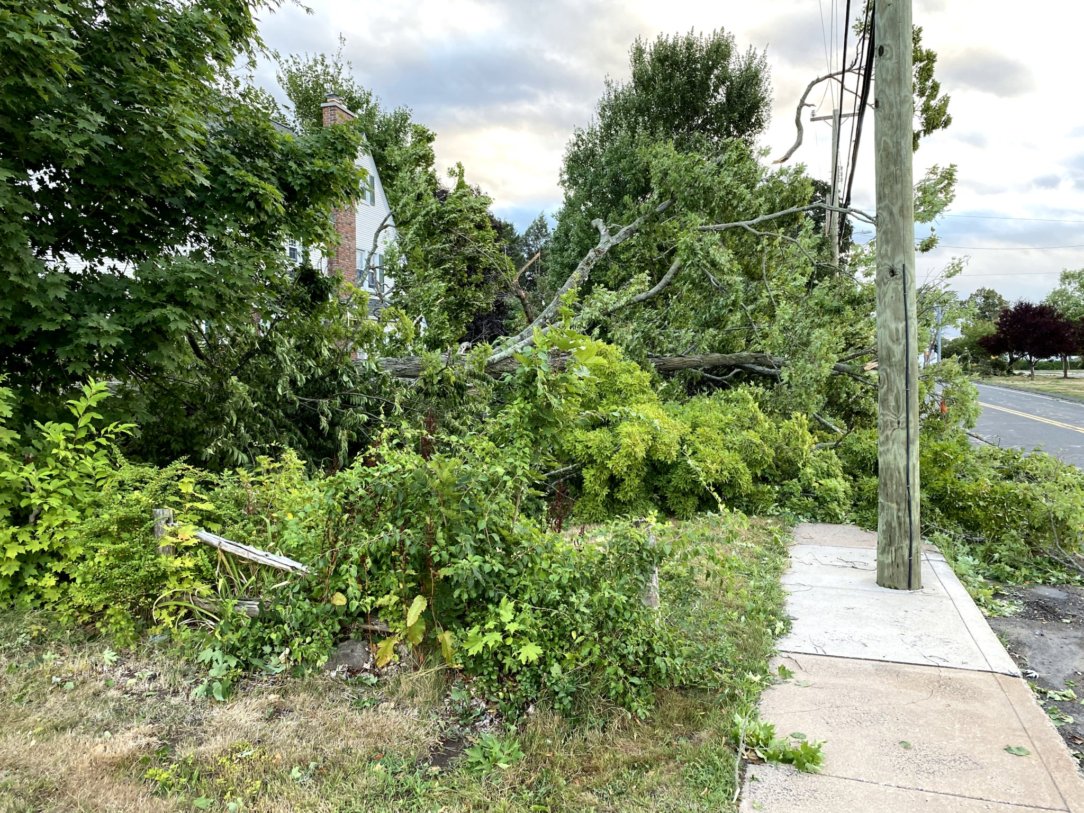Gypsy moth infestations and drought conditions in recent years have weakened trees throughout Connecticut to such an extent that forests were particularly vulnerable when the remnants of Hurricane Isaias swept through on Aug. 4, causing extensive power outages related to tree damage.
Those factors, along with the capricious storm’s unusual timing and localized pockets of extreme winds, made it more difficult than expected to predict the extent of possible electrical outages and create accurate restoration plans, according to a new analysis by the UConn-based Eversource Energy Center.
The center, based in UConn’s Innovation Partnership Building, is a research lab that develops storm damage modeling technology and forecasting to help Eversource – New England’s largest energy delivery company – plan for reliable service throughout Connecticut and New England.
Hurricane Isaias had weakened to a tropical storm by the time it reached Connecticut, but was unique in several ways that converged to contribute to the power outages that lasted for several days, according to the EEC’s analysis.
The EEC issued five predictions to Eversource between Aug. 1 and Aug. 4 for the utility company’s territory, and also shared four with United Illuminating, the state’s other large electric supplier. In almost every case, each report predicted significantly increasing storm severity, with the last predictions – released on the morning of Aug. 4, a few hours before the storm – indicating an extreme impact, in the range of 3,000 to 6,000 damage locations for Eversource service territory and 400 to 800 for United Illuminating.
Even given those increasingly ominous indicators, the storm’s damage exceeded the Outage Prediction Model (OPM) as strong winds blew through the state and non-meteorological factors – including the weakened and insect-damaged trees – became an unexpected part of the equation.
An extreme drought affected the region in 2016, and unusually dry conditions persist in much of the state. That had degraded the ability of many trees’ root systems to withstand sustained wind levels of a major weather event, particularly in northern areas of Connecticut. Also, tree canopy defoliations by Gypsy moth infestations in 2016, 2017 and 2018 created vulnerabilities statewide.
The UConn Outage Prediction Model (OPM) is a well-established, state-of-the-art model which uses weather forecasts, land cover, vegetation, and infrastructure characteristics, and historical outage records, to predict the amount of damage in the electric distribution system. Development stages and applications of the model have been published in several top tier peer-reviewed international journals, demonstrating its accuracy in predicting power outages for a host of weather events, including thunderstorms, hurricanes, nor’easters, and snow and ice storms.
Isaias’ unique characteristics affected the OPM modeling outcome in several ways, most particularly because the storm was disintegrating as it passed over the State of Connecticut, causing higher sustained winds and microbursts in localized circulations across a widespread area. In these localized pockets, sustained winds reached the level experienced in both Hurricanes Sandy (October 2012) and Irene (late August 2011).
At the same time, data included in the model for similar magnitude storms such as Sandy and Irene reflected significant meteorological differences between those storms and Isaias: Sandy occurred later in the year when leaf area was lower, and Irene involved greater precipitation levels.
In mid-summer, Connecticut’s forests have the highest leaf area for high winds to impact, causing more tree and branch movement than when leaf area is lower. With drought conditions weakening the strength of root systems to an unprecedented extent, the combination of these factors caused an extreme impact.
Moreover, the National Weather Service confirmed that a tornado, characterized by a maximum wind speed of 95 to 105 mph, occurred in Westport, where power outages were extensive. Other small tornadoes and microbursts are suspected to have taken place in some locations, further indicating localized pockets of extreme winds.
“When we issued the first prediction on Aug. 1, the hurricane was still located in the Bahamas and there was a significant uncertainty on the track,” said Emmanouil Anagnostou, EEC’s Director, and a UConn professor in the Department of Civil and Environmental Engineering.
“But at the time of the fifth and final prediction, during the morning of Aug. 4, a few hours before the storm, we were certain that the storm would produce an extreme impact in Connecticut, although not as severe as what actually developed due to the novel characteristics of Storm Isaias,” added Diego Cerrai, EEC’s manager and an assistant professor in the Department of Civil and Environmental Engineering.
Going forward, the EEC plans to incorporate more data on vegetation science and drought conditions in its modeling, helping to better predict future warm-season extreme storm impacts.
EEC researchers also say another key observation from tropical storm Isaias and its aftermath is the recognition that vegetation management should be implemented more widely, perhaps including more attention to large trees that have been outside of historical trimming zones. The EEC’s faculty members who specialize in natural resources will be analyzing data from the Center’s Stormwise forest management sites and remote sensing data from NASA to investigate tree damages as it continues reviewing the incident.
This year’s hurricane season is expected to be active, and lessons learned from predictions of tropical storm Isaias will be part of the EEC’s data it uses as it continues monitoring for ways in which future weather events could impact the power grid.



